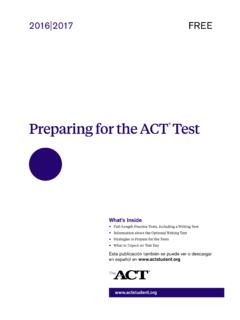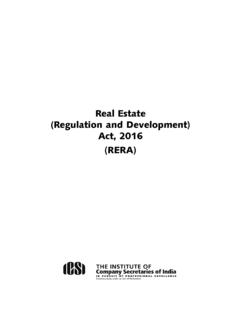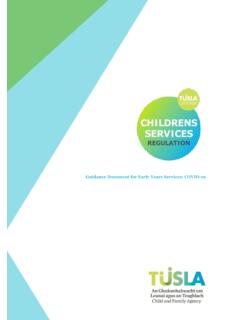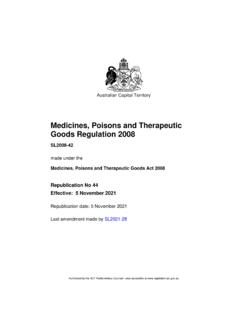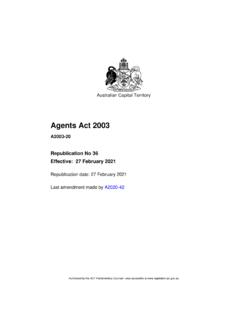Transcription of Preparing Analysis Data Model (ADaM) Data Sets and …
1 1 Paper 855-2017 Preparing Analysis Data Model (ADaM) Data Sets and Related Files for FDA Submission with SAS Sandra Minjoe, Accenture Life Sciences; John Troxell, Accenture Life Sciences ABSTRACT This paper compiles information from documents produced by the Food and Drug Administration (FDA), the Clinical Data Interchange Standards Consortium (CDISC), and Computational Sciences Symposium (CSS) workgroups to identify what Analysis data and other documentation is to be included in submissions and where it all needs to go. It not only describes requirements, but also includes recommendations for things that aren't so cut-and-dried. It focuses on the New Drug Application (NDA) submissions and a subset of Biologic License Application (BLA) submissions that are covered by the FDA binding guidance documents.
2 Where applicable, SAS tools are described and examples given. INTRODUCTION The purpose of this paper is to describe how to assemble Analysis data and related files for the submission of NDAs and most BLAs to FDA CDER and CBER. The deliverables discussed are Analysis datasets, other files related to Analysis datasets, Analysis programs, data definition files ( ) and the Analysis Data Reviewers Guide (ADRG). The material included here is based on requirements described in the two December 2014 FDA Binding Guidance documents: Providing Regulatory Submissions in Electronic Format Submissions Under Section 745A(a) ofthe Federal Food, Drug, and Cosmetic Act Providing Regulatory Submissions In Electronic Format Standardized Study DataThree other FDA documents that are related to these binding guidance documents and contain material relevant to this paper are.
3 Data Standards Catalog (08-31- 2016 ) Study Data Technical Conformance Guide (October 2016 ) Technical Rejection Criteria for Study Data (Revised 11142016)Additional documents used to compile this paper are published by the Clinical Data Standards Interchange Consortium (CDISC), the Computational Sciences Symposium (CSS) workgroups, and the Japan Pharmaceuticals and Medical Devices Agency (PMDA). The References section of this paper contains links to websites where all of these documents can be downloaded. Analysis DATA AND OTHER RELATED DATA Let s begin by defining Analysis data and other related data. Analysis DATASET DEFINTIONS The Analysis Data Model Implementation Guide (ADaMIG) defines three different types of datasets: Analysis datasets, ADaM datasets, and non-ADaM Analysis datasets: Analysis dataset An Analysis dataset is defined as a dataset used for Analysis and reporting.
4 ADaM dataset An ADaM dataset is a particular type of Analysis dataset that either: (1)is compliant with one of the ADaM defined structures and follows the ADaM fundamentalprinciples; or2 (2) follows the ADaM fundamental principles defined in the ADaM Model document and adheres as closely as possible to the ADaMIG variable naming and other conventions. Non-ADaM Analysis dataset A non-ADaM Analysis dataset is an Analysis dataset that is not an ADaM dataset. Examples of non-ADaM Analysis datasets include: an Analysis dataset created according to a legacy company standard an Analysis dataset that does not follow the ADaM fundamental principles. This same document includes a figure showing the relationships of these types of datasets: Basically, an Analysis dataset is either an ADaM dataset or a non-ADaM Analysis dataset.
5 There are three standard structural classes of ADaM datasets: ADSL (Subject-Level Analysis Dataset) BDS (Basic Data Structure) OCCDS (Occurrence Data Structure) if using ADaMIG ; or ADAE (Adverse Event Analysis Dataset) if using ADaMIG Occasionally, there may be an Analysis need which no standard structure can address. For example, no standard structure enables generation of a correlation matrix of time-varying dependent variables. In that case, the unmet Analysis need can be addressed by designing a dataset with a non-standard structure. Such a dataset is an ADaM dataset only if follows all of the ADaM fundamental principles and other ADaM conventions. These true ADaM datasets that cannot follow a standard ADaM structure are considered to be members of the ADaM Other class of ADaM datasets.
6 A non-ADaM Analysis dataset is any Analysis dataset that is not compliant with ADaM. Non-ADaM Analysis datasets are not broken down into structures or classes the way ADaM datasets are. Figure 1: copy of ADaMIG Figure Categories of Analysis Datasets 3 STANDARDS ACCEPTED BY FDA The FDA Data Standards Catalog (08-31- 2016 ) lists all supported and required standards. For Analysis data, the only standards included are ADaM and ADaMIG The FDA Study Data Technical Conformance Guide (SDTCG) states that they will also accept standards described in the following CDISC Therapeutic Area User Guides (TAUGs): Chronic Hepatitis C Dyslipidemia Diabetes QT Studies Tuberculosis These TAUG standards are developed quickly and are often finalized before ADaM documents can be updated.
7 WHY DOES FDA WANT ADAM? Standards are developed and used for many reasons, including to increase efficiency. The FDA SDTCG states that ADaM facilitates their review, simplifies programming steps necessary for performing Analysis , and promotes traceability from Analysis results to ADaM datasets to SDTM datasets. Specifics not mentioned in the FDA documents are that reviewers have been receiving more and more ADaM data and are getting used to using it. They ve also been provided training and tools to help them use this data in their reviews. FORMAT OF DATASETS SUBMITTED TO THE FDA The FDA SDTCG states that the only way electronic datasets can be submitted to the FDA is in the file format of SAS Transport Format v5.
8 These transport files can be created using SAS PROC COPY or in a DATA step. Native SAS datasets such as those with extension sas7bdat , as well as transport files created using SAS PROC CPORT, are not accepted. Although SAS PROC COPY allows multiple SAS datasets to be combined into a single transport file, FDA requires that for submission each SAS dataset be converted into a SAS transport file. Moreover, the name of the transport file must have the same name as the dataset. For example, must be converted to Information Beyond the FDA Documents The reason for the requirement of this old version of the SAS transport file is that SAS v5 transport is an open file format. In other words, data can be translated to and from SAS v5 transport and other commonly used formations without the use of programs from SAS Institute (or any other specific vendor).
9 Because the v5 file format is so old, it doesn t understand many of the newer features of SAS. In fact, this is the reason CDISC data standards such as SDTM and ADaM restrict dataset and variable names to 8 characters, dataset and variable labels to 40 characters, and character variable lengths to 200 characters or less. Longer versions of any of these items will be truncated and/or an error message will be generated when the transport file is created. Also watch out for newer or user-specified SAS display formats. Any format that isn t known to SAS v5 transport will be lost when the transport file is created. For dates, this means displays of the date, such as via the SAS Viewer or PROC PRINT, will show the number of days since Jan 1, 1960, the underlying content of the date variable.
10 For times and datetimes, this means that a number of seconds will appear. Only use formats that are standard in SAS V5. 4 To ensure that no data or formatting is lost when creating the SAS transport file, consider using a validation process such as: (1) Create a SAS dataset (2) Create a SAS v5 transport file from the SAS dataset using SAS PROC COPY or the DATA step. For example: libname adam "C:\desktop\data\adam"; libname xptfile xport "C:\desktop\data\xport\ "; data ; set ; run; (3) Convert the SAS v5 transport file into a new SAS dataset. For example: libname xptfile xport "C:\desktop\data\xport\ "; libname new "C:\desktop\data\new\"; data ; set ; run; (4) Use SAS PROC COMPARE to compare the new dataset with the original version to check for discrepancies.










